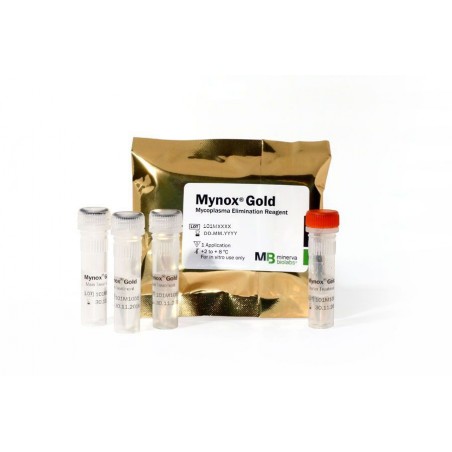- Online only




Let us notify you about our product updates.
Mynox® Gold is a further development of the classic Mynox®. Mynox® Gold is a combination of a standard antibiotic ciprofloxacin with the biological Mynox® reagent surfactin. One application includes an initial treatment that eliminates most mycoplasmas without affecting the cells. The follow-up treatments destroy the remaining mycoplasmas. The mode of action of Mynox® Gold is based on a biophysical mechanism to integrate into the membrane of mycoplasmas and thereby impair their integrity.
Technical Note on the functional testing of Mynox® Gold. Removal of mycoplasma from a Vero cell line contaminated with mycoplasma.
The combination of the standard antibiotic ciprofloxacin and the Mynox® reagent surfactin virtually eliminates the possibility of resistance to Mynox® Gold when eliminating mycoplasmas.
The eradication efficiency is close to 100 %.
Protocol for the pre-treatment of virus stocks available as a Technical Note.
Mynox® Gold is intended for research use only and not for clinical applications. Not applicable for the direct treatment of cells that serve as host cells for Chlamydia or other bacterial host cells. The level of antibiotics in the product may affect the integrity of the parasites.
One application of Mynox® Gold contains one vial for the starter treatment and three vials for the main treatment. Each vial contains 500 µl as a sterile, ready-to-use solution.
A single application is sufficient to permanently remove mycoplasma from a cell culture.
Elimination success should be verified with a suitable mycoplasma detection system, e.g. Minerva Biolabs' Venor®GeM Mycoplasma PCR Detection Kits.
25 cm2 cell culture flasks or tissue culture petri dishes (60 mm Ø)
Standard cell culture plasticware
Standard cell culture equipment (incubator, centrifuge, pipettes, etc.)
Store the components at +2 °C to +8 °C until the expiry date indicated on the label. Protect from light.
Minerva Biolabs offers a free sample of this product for testing:
Request free sample